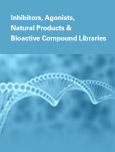| Cat. No. |
Product Name |
Information |
| PC-45905 |
Plerixafor octahydrochloride
CXCR4 inhibitor
|
Plerixafor octahydrochloride (JM-3100, AMD3100, SID-791) is a potent, selective CXCR4 inhibitor (IC50=44 nM) that inhibits the replication of various HIV-1 and HIV-2 strains in various cell lines with EC50 of 10 ng/ml. |
| PC-42164 |
AMD3100
CXCR4 inhibitor
|
Plerixafor (AMD3100) is a potent, selective CXCR4 inhibitor (IC50=44 nM) that inhibits the replication of various HIV-1 and HIV-2 strains in various cell lines with EC50 of 10ng/ml. |
| PC-45838 |
INCB3344
CCR2 antagonist
|
INCB3344 (INCB 3344) is a potent, selective and orally bioavailable CCR2 antagonist with IC50 of 5.1 nM and 9.5 nM for hCCR2 and mCCR2, respectively, in MCP-1 binding assays. |
| PC-42073 |
SCH-546738
CXCR3 inhibitor
|
SCH-546738 (SCH546738) is a potent, selective and non-competitive CXCR3 antagonist with binding Ki of 0.4 nM for human CXCR3. |
| PC-42055 |
SCH-563705
CXCR1/CXCR2 inhibitor
|
SCH-563705 is a potent, orally bioavailable dual CXCR2/CXCR1 receptor antagonist with IC50 of 1.3 nM and 7.3 nM, respectively. |
| PC-45199 |
Vicriviroc maleate
CCR5 antagonist
|
Vicriviroc maleate (SCH417690) is a potent, highly selective, and orally bioavailable CCR5 antagonist with Ki of 2.5 nM. |
| PC-42300 |
CXCR2-IN-1
CXCR2 antagonist
|
CXCR2-IN-1 is a potent, CNS penetrant CXCR2 antagonist with pIC50 of 9.3. |
| PC-45834 |
MK-0812 succinate
CCR2 antagonist
|
MK-0812 succinate is a potent CCR2 specific antagonist that blocks MCP-1 mediated response with an IC50 of 3.2 nM. |
| PC-45833 |
MK-0812
CCR2 antagonist
|
MK-0812 is a potent CCR2 specific antagonist that blocks MCP-1 mediated response with an IC50 of 3.2 nM. |
| PC-45483 |
RS102895
CCR2 antagonist
|
RS-102895 (Abaucin, RS102895) is a potent and specific CCR2 antagonist with binding IC50 of 360 nM, also is a narrow-spectrum activity against A. baumannii. |
| PC-45482 |
RS102895 hydrochloride
CCR2 antagonist
|
RS102895 hydrochloride is a potent and specific CCR2 antagonist with binding IC50 of 360 nM. |
| PC-45824 |
AMD-070 hydrochloride
CXCR4 antagonist
|
AMD-070 (Mavorixafor) hydrochloride is a potent and selective antagonist of CXCR4 with IC50 of 13 nM in a CXCR4 125I-SDF inhibition binding assay. |













